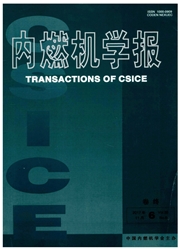

 中文摘要:
中文摘要:
为研究柴油/甲醇二元燃料的缸内燃烧过程,基于对二元燃料燃烧特征的分析,发展了湍流耦合反应动力学的柴油/甲醇二元燃料缸内燃烧机理和燃烧模型.基于一个已有的甲醇/正庚烷二元燃料燃烧机理,进一步提高了机理的预测精度,燃烧模型通过计算混合时间尺度和化学反应时间尺度来衡量燃烧的受控因素,其中化学反应时间尺度以熵增率衡量.通过发动机试验对模型进行了标定和验证,结果表明:该燃烧机理和燃烧模型能够很好地对纯柴油和柴油/甲醇二元燃料燃烧过程进行预测,包括随着甲醇比例的增加,滞燃期延长,甲醇火焰传播预混燃烧放热峰值逐渐明显.采用直接求解化学反应而不考虑湍流的燃烧模型,对燃烧进程的预测结果则随着甲醇量的增加而逐渐高于试验值.
 英文摘要:
英文摘要:
A kinetic mechanism and a new combustion model for diesel/methanol in-cylinder combustion were developed on the basis of in-cylinder combustion analysis. The mechanism prediction was improved compared with a previous methanol/n-heptane skeletal mechanism. The combustion model was developed with the assumption that the reaction rate for each species is determined by the kinetic process and relative magnitude of mixing and reaction effects, which are characterized by turbulence time scale and a kinetic time scale. The kinetic time scale was evaluated by the increment rate of entropy. Experiments were con- ducted on a modified heavy-duty diesel engine under low methanol ratios. Ignition delay is increased with the increase of methanol ratio, and the heat release of methanol premixed combustion becomes obvious. While the direct chemical solution (DCS) without considering the turbulence overestimates the combus- tion process with the increase of methanol addition. The new combustion model shows an improved per- formance in predicting conventional diesel combustion and diesel/methanol dual-fuel combustion to the experimental results.
 同期刊论文项目
同期刊论文项目
 同项目期刊论文
同项目期刊论文
 Experimental investigation on regulated and unregulated emissions of a diesel/methanol compound comb
Experimental investigation on regulated and unregulated emissions of a diesel/methanol compound comb Experimental and Computational Studies on Ignition Characteristics of Diesel in a Premixed Ethanol-A
Experimental and Computational Studies on Ignition Characteristics of Diesel in a Premixed Ethanol-A Simulations of diesel-methanol dual-fuel engine combustion with large eddy simulation and Reynolds-a
Simulations of diesel-methanol dual-fuel engine combustion with large eddy simulation and Reynolds-a Experimental and modelling studies of the effects of methanol and ethanol addition on the laminar pr
Experimental and modelling studies of the effects of methanol and ethanol addition on the laminar pr Experimental and modeling study of the effect of ethanol and MTBE on the oxidation of PRF90 in low p
Experimental and modeling study of the effect of ethanol and MTBE on the oxidation of PRF90 in low p 期刊信息
期刊信息
